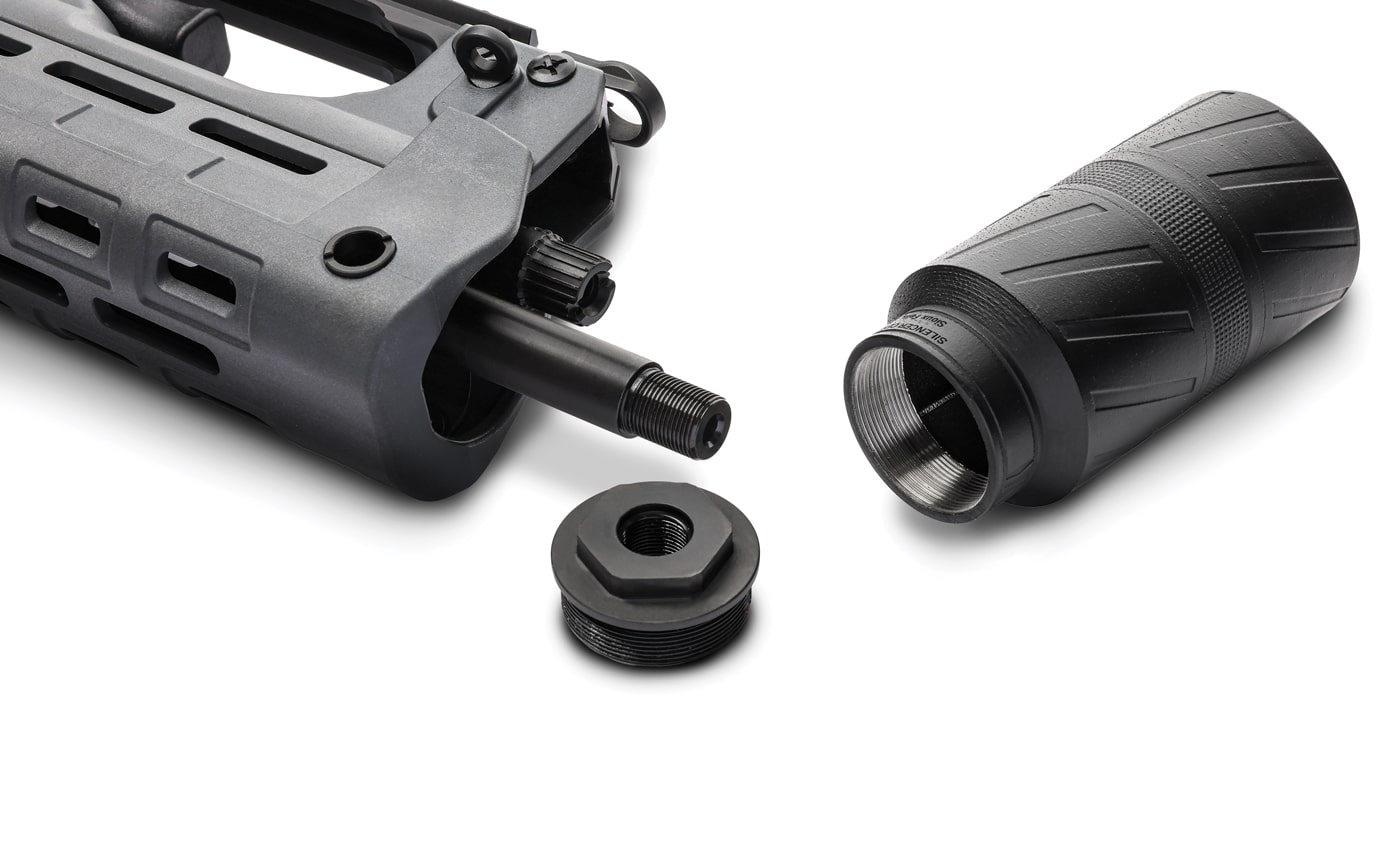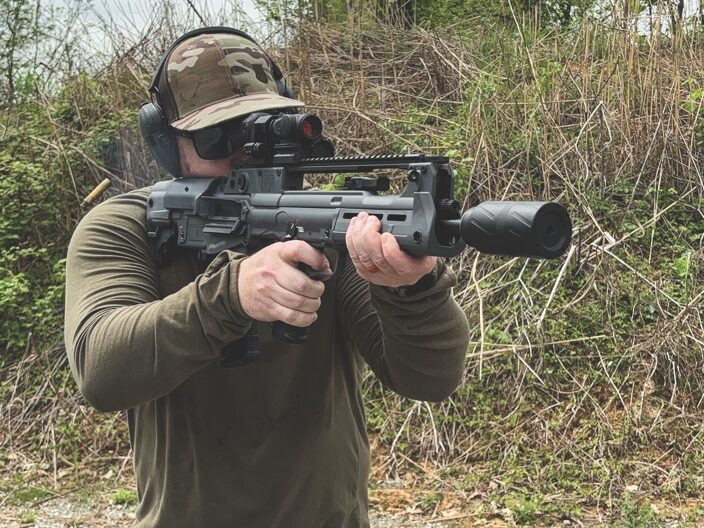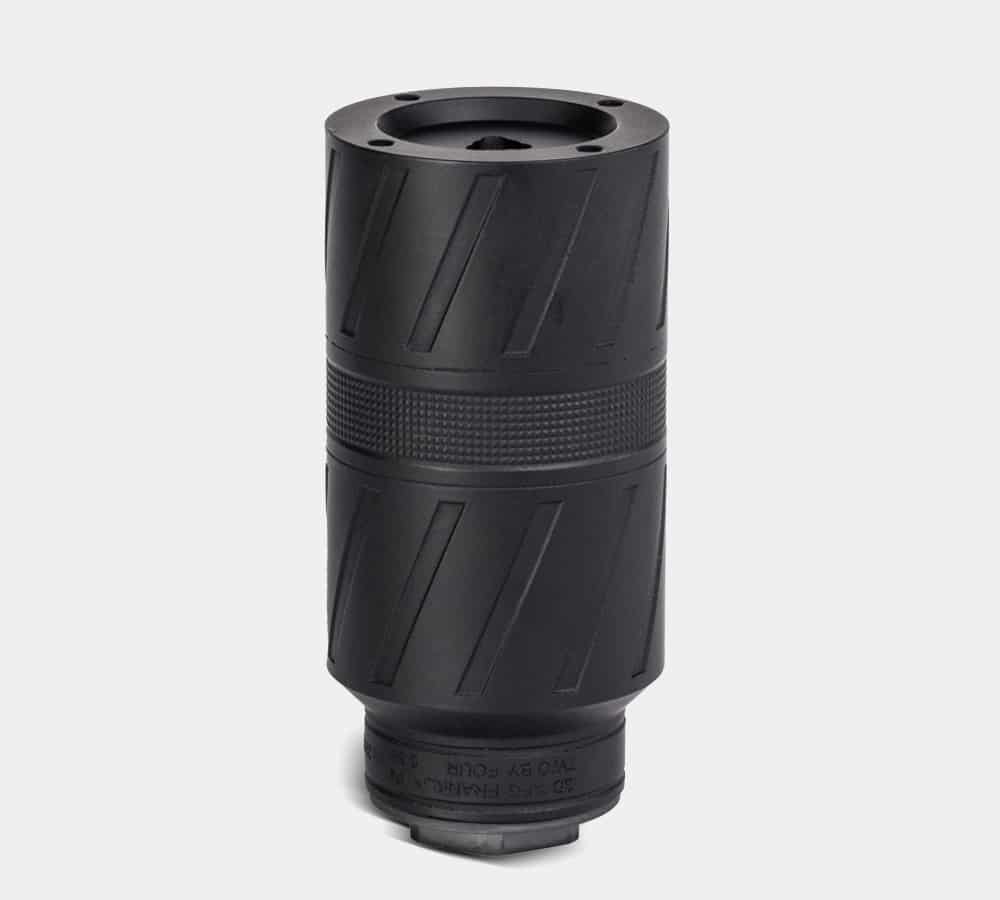Silencer Central is known for two serious contributions to the shooting industry: Reimagining the suppressor purchase process, and its comprehensive line of Banish silencers. Regarding the latter, a recent addition to the family really stands out from the crowd — the Banish Speed K.
The Speed K is different. For starters, it doesn’t look like its stablemates. It was engineered and built differently than the rest of the line so that, ultimately, it would perform differently.
Design priorities for most suppressors are noise reduction and cost. The whole point is to quiet the volume of a gun’s report, so a viable suppressor simply has to work. In addition, the market for suppressors is highly competitive, so price and value also play a significant role.
Prior to the Speed K, Silencer Central pursued these sound objectives to a tee, and built the Banish line to offer excellent noise reduction and notable versatility at a fair price. Characteristics of the line included traditional stacked-baffle internal configurations as well as durable titanium construction. The result is tough, lightweight suppressors that offer top-tier noise reduction without top-tier costs.
Too, most Banish suppressors are multi-caliber units that utilize a variety of interchangeable mounts and adapters to accommodate different muzzle thread pitches. Some are also modular, allowing users to add or remove baffles for greater suppression or improved portability. One example, the Banish 30, can handle any cartridge from .17-caliber rimfires up to .30-cal. magnums. It can also be run in either a 7” or 9” configuration.

For what it’s worth, my personal recommendation to first-time suppressor shoppers is to start with a utility .30-cal. can exactly like the Banish 30. Most folks get hooked by the benefits of suppressed shooting — the reduced noise and recoil — and will become repeat shoppers. With offerings from the Banish 22 (.17 HMR, .22 LR, 5.7x28mm, etc.) up to the Banish 46 (.45-70 Gov’t, .338 Lapua, and below), Silencer Central has them covered.
[Check out our article on suppressor internals.]
To sum up, Banish series suppressors are versatile, lightweight, durable, and, of course, quiet. They are ideal for recreational and hunting pursuits. The Banish Speed K, though, like I said, is different.
Performance Priorities
Why depart from a proven recipe and make the Speed K different? The answer stems from its intended use case, its raison d’etre. Unlike the rest of the suppressors in the Banish line, the Speed K was designed specifically for use on a semi-auto (or even select-fire) carbine chambered for 5.56×45 NATO/.223 Remington. Further, it was intended to answer law enforcement requests for a new kind of suppressor — yet still provide a benefit that would appeal to the civilian shooter as well.

The issue can be summed up in one word — backpressure. Most people who have fired a suppressed semi-automatic rifle likely remember the blast of hot, pressurized gas that hits as the shot goes off. For a few shots? Not a huge deal. For a sustained string of shots — particularly at a good pace — it can become a real issue.
Backpressure reduction now tops the wish list for tactically oriented suppressors — whether for LE- and military-oriented uses, while also offering benefits to civilian shooters — and the answer is fairly simple. Let more gas out the front. The problem is, if you let more gas flow quickly through the suppressor to mitigate backpressure, you are also letting more noise out the front.
Enter the Banish Speed K. In consultation with dozens of professional end-users, Silencer Central set out to design a hybrid flow-through suppressor that would reduce backpressure, but still provide hearing-safe noise suppression. They also reimagined the external dimensions in order to reduce the silencer’s length, ensuring that Speed K-equipped carbines would be portable and maneuverable within tight environments.
Construction & Materials
To pull off this radical departure from the company’s previous suppressor designs, Silencer Central employed both a different construction material and a new manufacturing technique.
To achieve a balance of flow-through and noise suppression, the Speed K incorporates a sophisticated array of internal blast chambers, baffles and vents to contain and control the energy and movement of gases. The components each play a role in capturing, slowing, directing and releasing the shot blast’s energy and gas.

Such a complex configuration would be difficult, or impossible, to create with traditional reductive manufacturing methods, such as using a CNC machine. Too, welding machined parts together can create potential weak points, and you can be sure that a can intended for tactical use is going to be stressed.
The company’s solution was visionary. The Speed K is entirely made from Inconel through the additive process of 3D printing. The use of Inconel 718 alloy is not new to suppressor design, but it is still somewhat exotic. The material is similar in weight and strength to stainless steel, but it is renowned for its heat resistance. In fact, Inconel is probably best known for its use on spacecraft engines because it can withstand the blast from rocket boosters. Using a 3D printer, complex internals designs become easy to achieve as the material is simply added layer by layer, with no welds required.
In addition to the Inconel version I did all my testing with, which weighs in at 14.1 oz. and has an MSRP of $1,199, Silencer Central also offers a Speed K constructed of titanium. That version weighs in at 8.6 oz. and has an MSRP of $1,399. Both feature a black Cerakote finish.
Hands-On
The result is an absolute unit. The Speed K is a monolithic, mono-metal suppressor that is both surprisingly short and deceptively hefty. With a direct thread adapter installed, the can is about 4.25” tall and weighs just more than a pound in the Inconel variant I was testing. Its body diameter is right about 2”. In the hand, it reminds me of the size and weight of a smoke grenade.
Unlike Silencer Central’s multi-caliber offerings, the Speed K is intended to be a dedicated 5.56/.223 muzzle device. However, it is compatible with a wide range of rifle makes and models because it mounts using industry-standard HUB-pattern adapters. The can has an integral collar below the main body, the inside of which is threaded 1.375×24 to accept thread-specific muzzle adaptors. Silencer Central includes one with the purchase of the Speed K and others can be added separately. There are eight thread options to choose from but, given the chambering, 1/2×28 is going to be the most common selection. The mounting adapters are made of titanium.

For testing, I figured if we are going to go short, let’s really go short, so I affixed the Speed K to a Springfield Armory Hellion. The 16”-barreled Hellion has an overall length of less than 30”, so even by adding about 4” for the suppressor, the bullpup is still shorter than a standard length, 16”-barrel unsuppressed AR. That’s an appealing package for defensive work in tight terrain.
I shot a variety of .223 and 5.56 ammunition to test functionality, and there were no problems. Happily, there was also no perceptible backpressure. Even shooting rapid strings, it seemed that the Speed K’s flow-through design was working perfectly. Too, the added heft at the muzzle helped keep the rifle from rising during recoil, so I had the impression of a very flat-shooting carbine.
One of the nice features of the Hellion is its two-position adjustable gas block, “N” for normal, unsuppressed use, and “S” for suppressed shooting. Between the Hellion’s piston-driven operating system and the flow-through qualities of the Speed K, I did not need to make any adjustments. With standard velocity ammunition, the gun cycled reliably without feeling over-pressured. It was nice to know, though, that if I wanted to shoot a spicy 75-grain 5.56 NATO load — or use a less sophisticated suppressor — the gun has a tunable gas system to accommodate.

The Speed K earns high marks for its compact design and the way it handles backpressure, but how does it sound? According to Silencer Central, the suppressor offers 20.9 decibels (Db) of noise reduction. As a result, the Speed K should bring the volume of carbine fire (approximately 160 Db) down to the edge of “hearing safe” (140 Db). I put the latter level in quotes because prolonged exposure to suppressed gunfire can still cause lasting damage to your hearing. Do yourself a favor and wear some ear protection whenever you go shooting, suppressed or not.
Conclusion
Having gone hands-on with the Speed K, I have nothing but admiration for the feat of engineering that it represents. As a dedicated suppressor for defensive-style rifles, the Speed K from Silencer Central is a great option. I couldn’t be happier the company is pressing forward in this new direction.
Editor’s Note: Please be sure to check out The Armory Life Forum, where you can comment about our daily articles, as well as just talk guns and gear. Click the “Go To Forum Thread” link below to jump in and discuss this article and much more!
Join the Discussion
Featured in this article
Read the full article here




